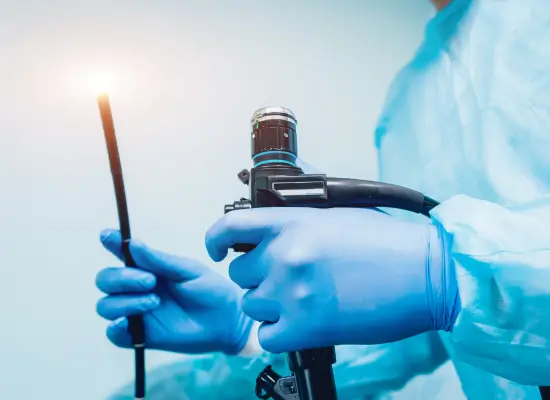Recovery time is variable, but most people return to normal activities within a few weeks, with little discomfort and quicker healing than with traditional surgery.

- Synopsis
- Introduction
- What is Otoendoscopy?
- Why Choose Otoendoscopy for Various Ear Conditions?
- Types of Otoendoscopes
- Preparation for Endoscopic EAR Surgery in Bangalore
- The Procedure of Endoscopic EAR Surgery in Bangalore
- Risks and Complications
- Why Choose Gleneagles Hospital for Endoscopic Ear Surgery in Bangalore?
Synopsis
Ever wondered how doctors examine the ear with precision without causing much discomfort? Otoendoscopy might be the answer you're looking for. This article has every detail you may be looking for, from the introduction to the risks and complications associated with the procedure. The article also contains information about the best hospital for ear surgery, particularly in Bangalore.
Introduction
Ear problems can sometimes be complex to diagnose. The ear is one of the most sensitive and complex organs, which makes it quite difficult to know the main cause of the issue just by peeking into it. Owing to this, Otoendoscopy has emerged as the most successful treatment as well as diagnosis of ear issues, which include:
- Ear Infections
- Hearing Loss
- Perforated Eardrum
- Tinnitus, etc.
Being a surgery for a highly sensitive body organ, it is important to choose a healthcare centre which provides high success rates with precision and accuracy, both of which are the exclusive expertise of Gleneagles Hospital in Bangalore; we will discuss further more about this leading healthcare faculty in the subsequent sections. First, let's learn about this revolutionary new-age procedure of medicine.
What is Otoendoscopy?
Otoendoscopy is an operation that takes advantage of the use of an endoscope, which is a narrow, plastic tube with light and camera functions, to scope the internal anatomy of the ear. The key function of the instrument is to gain a better, enlarged perspective of the middle ear, eardrum, and ear canal, which proves difficult to assess by other means. The video from the camera is relayed in high-definition format to a monitor screen for the doctor's observation, providing an accurate ear assessment.
What distinguishes Otoendoscopy from other procedures is that it provides real-time, high-definition images that allow for rapid and accurate diagnosis. It is a wonderful instrument for those patients with ear problems like hearing loss, infection of the ears, earaches, or even balance issues.

Why Choose Otoendoscopy for Various Ear Conditions?
Otoendoscopy is not just a diagnostic tool but an important tool in the treatment of these ear conditions. It has several benefits over traditional surgical methods. Here is a list of reasons why you should choose Otoendoscopy over any other surgery:
- Real-Time Imaging: one of the best benefits of the method is that it can produce real-time and live images of the ear, helping doctors to get precise and immediate diagnoses of disease and launch a treatment plan without further delay.
- Minimally Invasive: Unlike traditional diagnostic and treatment methods, Otoendoscopy offers a less invasive solution for all types of ENT problems with the same precision and accuracy as the former.
- Better Visualisation: The endoscope has the quality of providing the best and high-definition images, which eventually leads to a much clearer and sharper detailed view of the ear's internal structure and its anomaly, if any.
- Documentation: Although not a significant benefit, documentation can help track the status of the disease, how it progressed and how it is reacting to the treatment procedure, which helps monitor the effectiveness of the treatment over time.
Your health matters – get expert advice today.
Types of Otoendoscopes
Otoendoscopes are the devices used to diagnose and treat ear diseases, equipped with high-resolution cameras and light, ensuring precision in diagnosis. Based on the flexibility of the endoscope, it is classified as:
- Rigid Otoendoscope: As the name suggests, it is an endoscope that has a rigid body and is used primarily where surgery must be performed, and that requires stability in addition to precision. It provides stable as well as crisp images of superior quality; thus, it is specifically suitable for observing ear structures like the ear canal and the eardrum.
- Flexible Otoendoscope: It is employed in regions where the rigid Otoendoscope can not reach. This type is more versatile in comparison to its counterpart, making it an ideal tool for reaching difficult-to-reach regions inside the ear. The flexibility also causes less discomfort during the whole procedure and is more commonly used for pediatric patients.
Preparation for Endoscopic EAR Surgery in Bangalore
Before starting the actual process of Endoscopic EAR Surgery in Bangalore, you are required to undergo a series of medical and psychological examinations to ensure that you are suitable for the procedure. Following is a list of procedures and medical assessments that you might expect:
- Blood Tests: Blood tests are done to make sure that the patient can tolerate anaesthesia and to determine whether there are any underlying conditions that might complicate the surgery.
- Imaging: Anatomy of the ear and other structures is evaluated through advanced imaging techniques such as CT scan or MRI. Imaging techniques enable the surgeon to form a better idea about the middle ear and plan the operation in advance.
- Hearing Tests: Audiometric tests are used to find out the patient's hearing. The test is beneficial to the surgeon in knowing the effect of ear disease on the hearing capacity of the patient and how to plan the procedure.
- Screening for allergy: Make sure to share any of your allergies or allergic reactions to drugs with your healthcare provider to reduce the risks of any side effects of anaesthesia or any other surgical equipment.
- Fasting: Fasting for a minimum of 6-8 hours is advised in most cases before surgery. During this time, no food, water, or any other beverage should be taken.
The Procedure of Endoscopic EAR Surgery in Bangalore
The procedure for endoscopic ear surgery in Bangalore is the same as anywhere else in the world. It is typically done on an outpatient basis, which means you can go home after the surgery without any complications. The steps of surgery involve:
- Preparation: The patient sits comfortably, and the ear is cleaned if necessary to eliminate any excess earwax or debris that may affect the examination.
- Insertion of the Endoscope: This step includes inserting the endoscope into the ear canal. Patients might experience pressure but no pain during the process.
- Examination: The endoscope sends live, high-definition images to a monitor, enabling the ENT specialist to examine the ear canal, eardrum, and middle ear. The pictures taken by the endoscope are saved and stored for future reference and patient education.
- Minor Intervention (If Necessary): If necessary, minor interventions such as earwax removal, foreign bodies, or growths are done using special instruments inserted along with the endoscope.
- Completion: Once the examination and any intervention, if any, is done, the endoscope is removed carefully. The patient will be given instructions on any additional treatment or follow-up.
Risks and Complications
Endoscopic ear surgery in Bangalore is generally considered a safe procedure, but like every other surgical procedure, it also has its own demerits that are risks and complications associated with this surgery, which include:
- Mild Discomfort: Mild discomfort or pressure may be experienced by some patients during and after the procedure.
- Dizziness or Balance Issues: Although not permanent, dizziness or balance issues can be experienced after the procedure as a result of the changes in the ear structures made during the surgery.
- Minor Bleeding or Infection: Minor bleeding or infection can be experienced by patients in some rare instances, particularly if there is pre-existing damage in the ear.
Why Choose Gleneagles Hospital for Endoscopic Ear Surgery in Bangalore?
Gleneagles Hospital is the leading hospital in Endoscopic ear surgery in Bangalore and across India due to its innovative and multidisciplinary approach towards every surgical and non-surgical procedure. Since its start, the hospital has been a pioneer in using the best possible tools and techniques to give a successful outcome. Here's why you or your loved one should choose the hospital:
- Home to some of the most skilled and talented surgeons and doctors, who work together to give a positive result.
- Fully sanitised and hygienic rehabilitation centre for safe and sound aftercare of the patients.
- The hospital uses up-to-date surgical tools to ensure accuracy and precision during the diagnosis and treatment.
- Last but not least, a high success rate gives confidence to their patient about the procedure.
Our Doctors
View allFrequently Asked Questions
Yes, endoscopic ear surgery is safe and is conducted by experienced specialists in well-equipped facilities with little risk and complications.
It is also frequently used to treat chronic infections, perforated eardrums, cholesteatomas, and other ear conditions.
The majority of endoscopic ear surgeries in Bangalore are done under general anaesthesia so that the patient is not in discomfort during the procedure.
Most patients can resume work after a brief period of recovery, typically between several days to a week, depending on the complexity of the surgery.











